Associations Between Job Insecurity and Employee Well-being: A Report
VerifiedAdded on 2023/01/19
|12
|2655
|76
Report
AI Summary
This report investigates the associations between quantitative and qualitative job insecurity and employee well-being, focusing on a study conducted in the Belgian banking sector. The research explores how employees' concerns about job continuation (quantitative insecurity) and job quality (qualitative insecurity) relate to their job satisfaction and psychological distress. The study surveyed 15,000 employees across 63 banks, examining factors like job satisfaction, emotional distress, and control variables such as gender and age. The report uses regression analysis to assess the relationships between the two forms of job insecurity and employee well-being, finding that both quantitative and qualitative job insecurity negatively impact job satisfaction and are associated with higher levels of psychological distress. The methodology, limitations, and implications of the findings are discussed, highlighting the importance of addressing job insecurity to promote employee well-being.
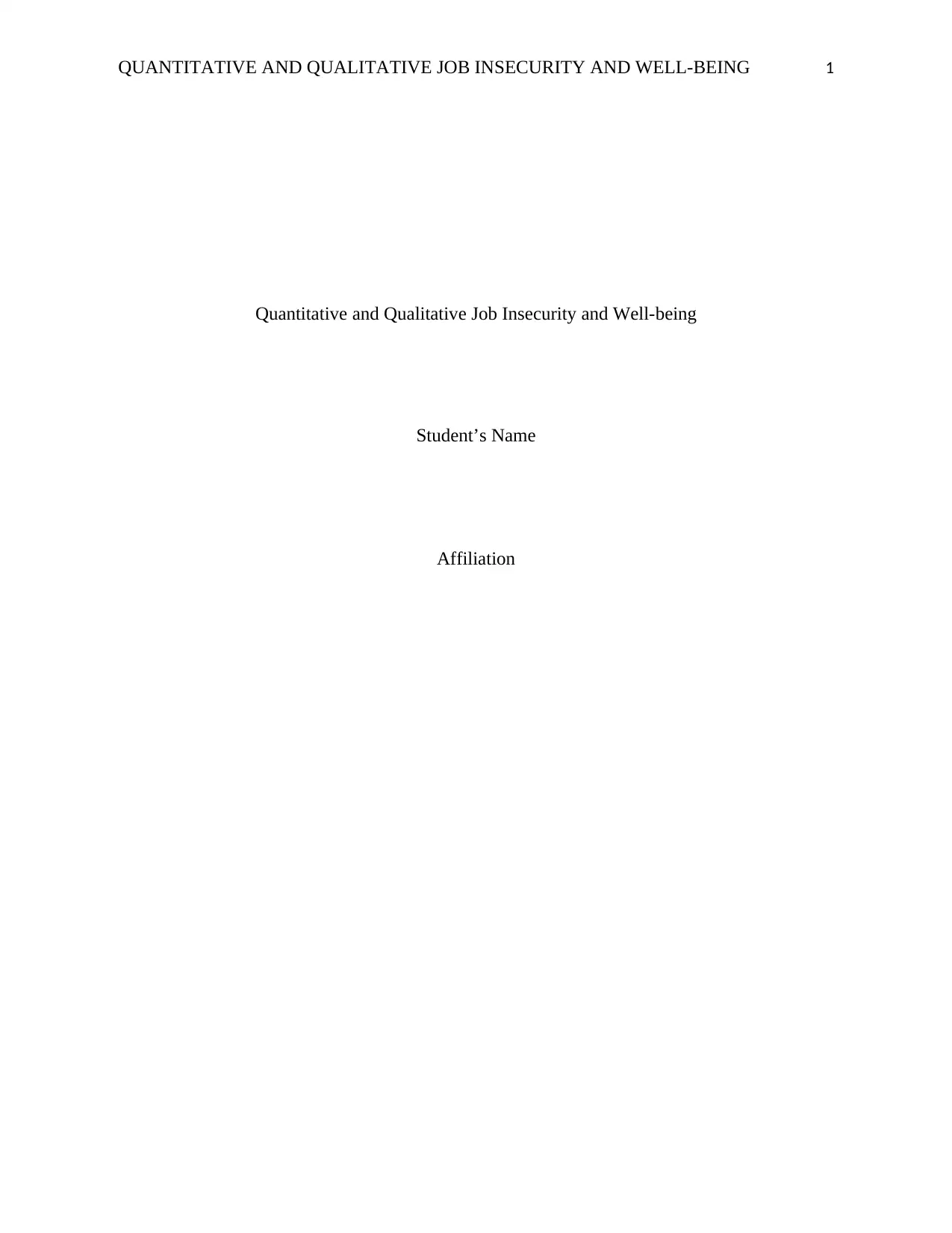
QUANTITATIVE AND QUALITATIVE JOB INSECURITY AND WELL-BEING 1
Quantitative and Qualitative Job Insecurity and Well-being
Student’s Name
Affiliation
Quantitative and Qualitative Job Insecurity and Well-being
Student’s Name
Affiliation
Paraphrase This Document
Need a fresh take? Get an instant paraphrase of this document with our AI Paraphraser

QUANTITATIVE AND QUALITATIVE JOB INSECURITY AND WELL-BEING 2
TABLE OF CONTENTS
1. Introduction 3
2. Background of the Study 3
3. Research Question 4
4. Measures 4
5. Research Methodology 5
a. Data analysis 5
b. Reliability of results 6
c. Discussion 7
d. Analysis of hypothesis 8
7. Limitations 10
8. Conclusion 11
9. References 12
TABLE OF CONTENTS
1. Introduction 3
2. Background of the Study 3
3. Research Question 4
4. Measures 4
5. Research Methodology 5
a. Data analysis 5
b. Reliability of results 6
c. Discussion 7
d. Analysis of hypothesis 8
7. Limitations 10
8. Conclusion 11
9. References 12
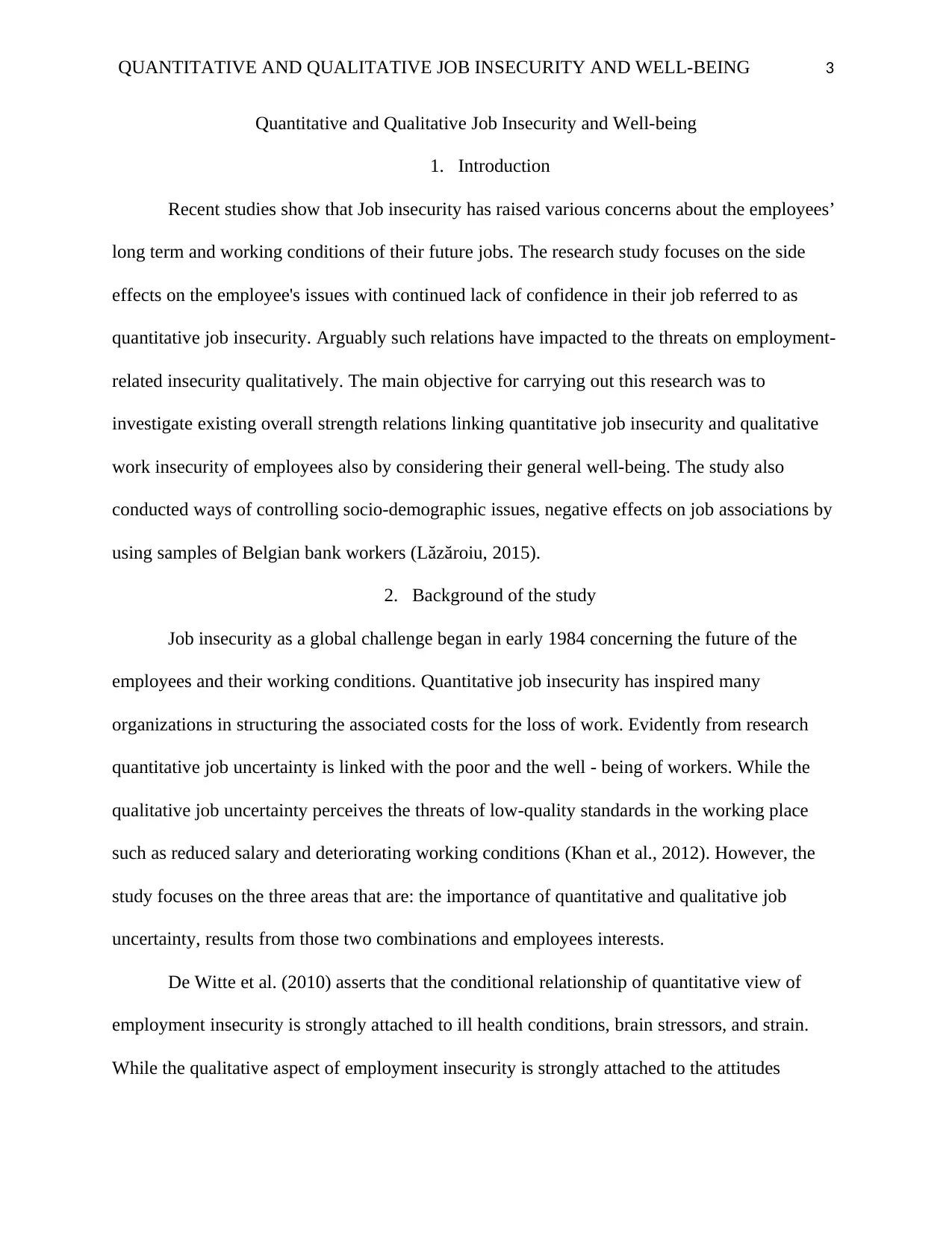
QUANTITATIVE AND QUALITATIVE JOB INSECURITY AND WELL-BEING 3
Quantitative and Qualitative Job Insecurity and Well-being
1. Introduction
Recent studies show that Job insecurity has raised various concerns about the employees’
long term and working conditions of their future jobs. The research study focuses on the side
effects on the employee's issues with continued lack of confidence in their job referred to as
quantitative job insecurity. Arguably such relations have impacted to the threats on employment-
related insecurity qualitatively. The main objective for carrying out this research was to
investigate existing overall strength relations linking quantitative job insecurity and qualitative
work insecurity of employees also by considering their general well-being. The study also
conducted ways of controlling socio-demographic issues, negative effects on job associations by
using samples of Belgian bank workers (Lăzăroiu, 2015).
2. Background of the study
Job insecurity as a global challenge began in early 1984 concerning the future of the
employees and their working conditions. Quantitative job insecurity has inspired many
organizations in structuring the associated costs for the loss of work. Evidently from research
quantitative job uncertainty is linked with the poor and the well - being of workers. While the
qualitative job uncertainty perceives the threats of low-quality standards in the working place
such as reduced salary and deteriorating working conditions (Khan et al., 2012). However, the
study focuses on the three areas that are: the importance of quantitative and qualitative job
uncertainty, results from those two combinations and employees interests.
De Witte et al. (2010) asserts that the conditional relationship of quantitative view of
employment insecurity is strongly attached to ill health conditions, brain stressors, and strain.
While the qualitative aspect of employment insecurity is strongly attached to the attitudes
Quantitative and Qualitative Job Insecurity and Well-being
1. Introduction
Recent studies show that Job insecurity has raised various concerns about the employees’
long term and working conditions of their future jobs. The research study focuses on the side
effects on the employee's issues with continued lack of confidence in their job referred to as
quantitative job insecurity. Arguably such relations have impacted to the threats on employment-
related insecurity qualitatively. The main objective for carrying out this research was to
investigate existing overall strength relations linking quantitative job insecurity and qualitative
work insecurity of employees also by considering their general well-being. The study also
conducted ways of controlling socio-demographic issues, negative effects on job associations by
using samples of Belgian bank workers (Lăzăroiu, 2015).
2. Background of the study
Job insecurity as a global challenge began in early 1984 concerning the future of the
employees and their working conditions. Quantitative job insecurity has inspired many
organizations in structuring the associated costs for the loss of work. Evidently from research
quantitative job uncertainty is linked with the poor and the well - being of workers. While the
qualitative job uncertainty perceives the threats of low-quality standards in the working place
such as reduced salary and deteriorating working conditions (Khan et al., 2012). However, the
study focuses on the three areas that are: the importance of quantitative and qualitative job
uncertainty, results from those two combinations and employees interests.
De Witte et al. (2010) asserts that the conditional relationship of quantitative view of
employment insecurity is strongly attached to ill health conditions, brain stressors, and strain.
While the qualitative aspect of employment insecurity is strongly attached to the attitudes
⊘ This is a preview!⊘
Do you want full access?
Subscribe today to unlock all pages.

Trusted by 1+ million students worldwide
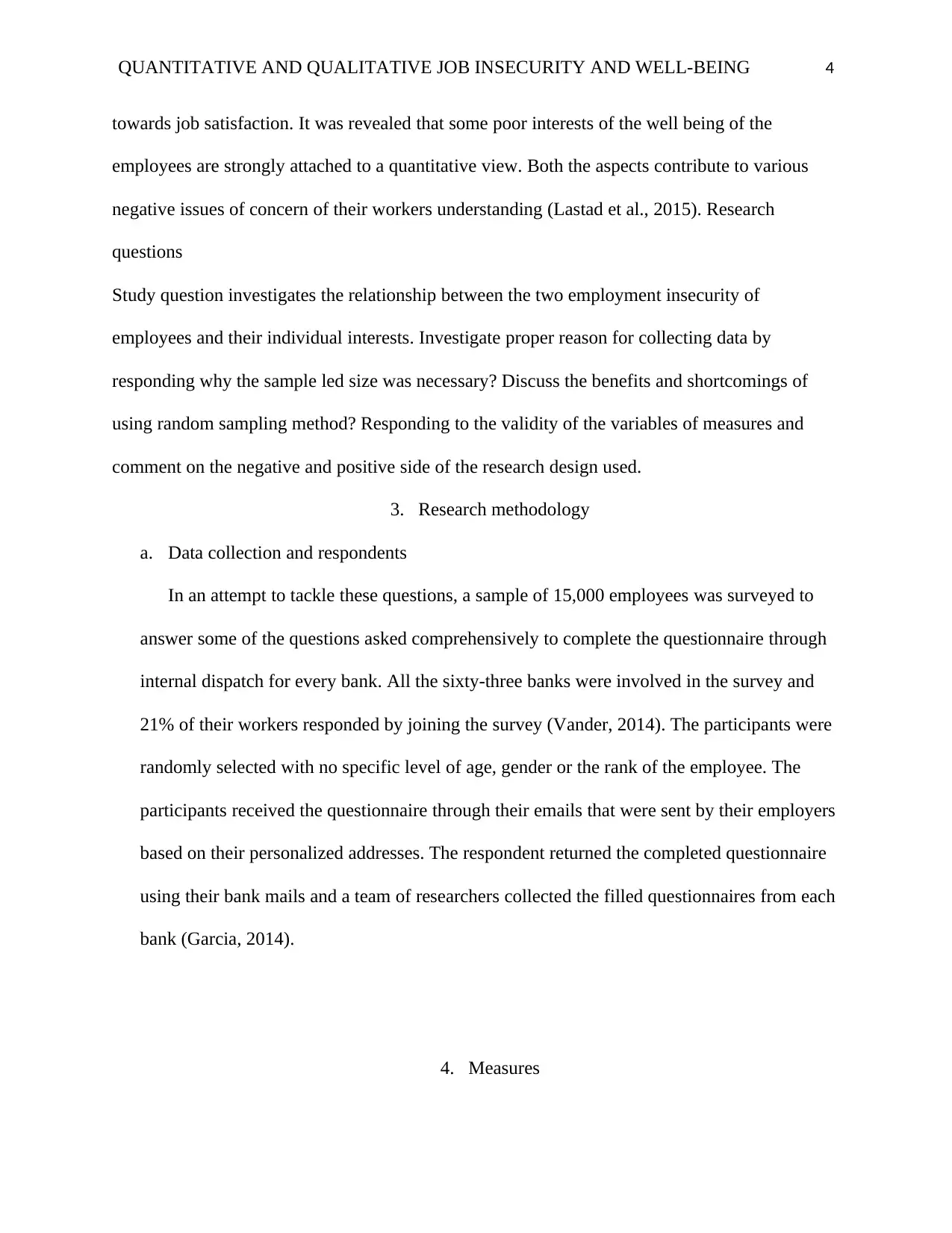
QUANTITATIVE AND QUALITATIVE JOB INSECURITY AND WELL-BEING 4
towards job satisfaction. It was revealed that some poor interests of the well being of the
employees are strongly attached to a quantitative view. Both the aspects contribute to various
negative issues of concern of their workers understanding (Lastad et al., 2015). Research
questions
Study question investigates the relationship between the two employment insecurity of
employees and their individual interests. Investigate proper reason for collecting data by
responding why the sample led size was necessary? Discuss the benefits and shortcomings of
using random sampling method? Responding to the validity of the variables of measures and
comment on the negative and positive side of the research design used.
3. Research methodology
a. Data collection and respondents
In an attempt to tackle these questions, a sample of 15,000 employees was surveyed to
answer some of the questions asked comprehensively to complete the questionnaire through
internal dispatch for every bank. All the sixty-three banks were involved in the survey and
21% of their workers responded by joining the survey (Vander, 2014). The participants were
randomly selected with no specific level of age, gender or the rank of the employee. The
participants received the questionnaire through their emails that were sent by their employers
based on their personalized addresses. The respondent returned the completed questionnaire
using their bank mails and a team of researchers collected the filled questionnaires from each
bank (Garcia, 2014).
4. Measures
towards job satisfaction. It was revealed that some poor interests of the well being of the
employees are strongly attached to a quantitative view. Both the aspects contribute to various
negative issues of concern of their workers understanding (Lastad et al., 2015). Research
questions
Study question investigates the relationship between the two employment insecurity of
employees and their individual interests. Investigate proper reason for collecting data by
responding why the sample led size was necessary? Discuss the benefits and shortcomings of
using random sampling method? Responding to the validity of the variables of measures and
comment on the negative and positive side of the research design used.
3. Research methodology
a. Data collection and respondents
In an attempt to tackle these questions, a sample of 15,000 employees was surveyed to
answer some of the questions asked comprehensively to complete the questionnaire through
internal dispatch for every bank. All the sixty-three banks were involved in the survey and
21% of their workers responded by joining the survey (Vander, 2014). The participants were
randomly selected with no specific level of age, gender or the rank of the employee. The
participants received the questionnaire through their emails that were sent by their employers
based on their personalized addresses. The respondent returned the completed questionnaire
using their bank mails and a team of researchers collected the filled questionnaires from each
bank (Garcia, 2014).
4. Measures
Paraphrase This Document
Need a fresh take? Get an instant paraphrase of this document with our AI Paraphraser
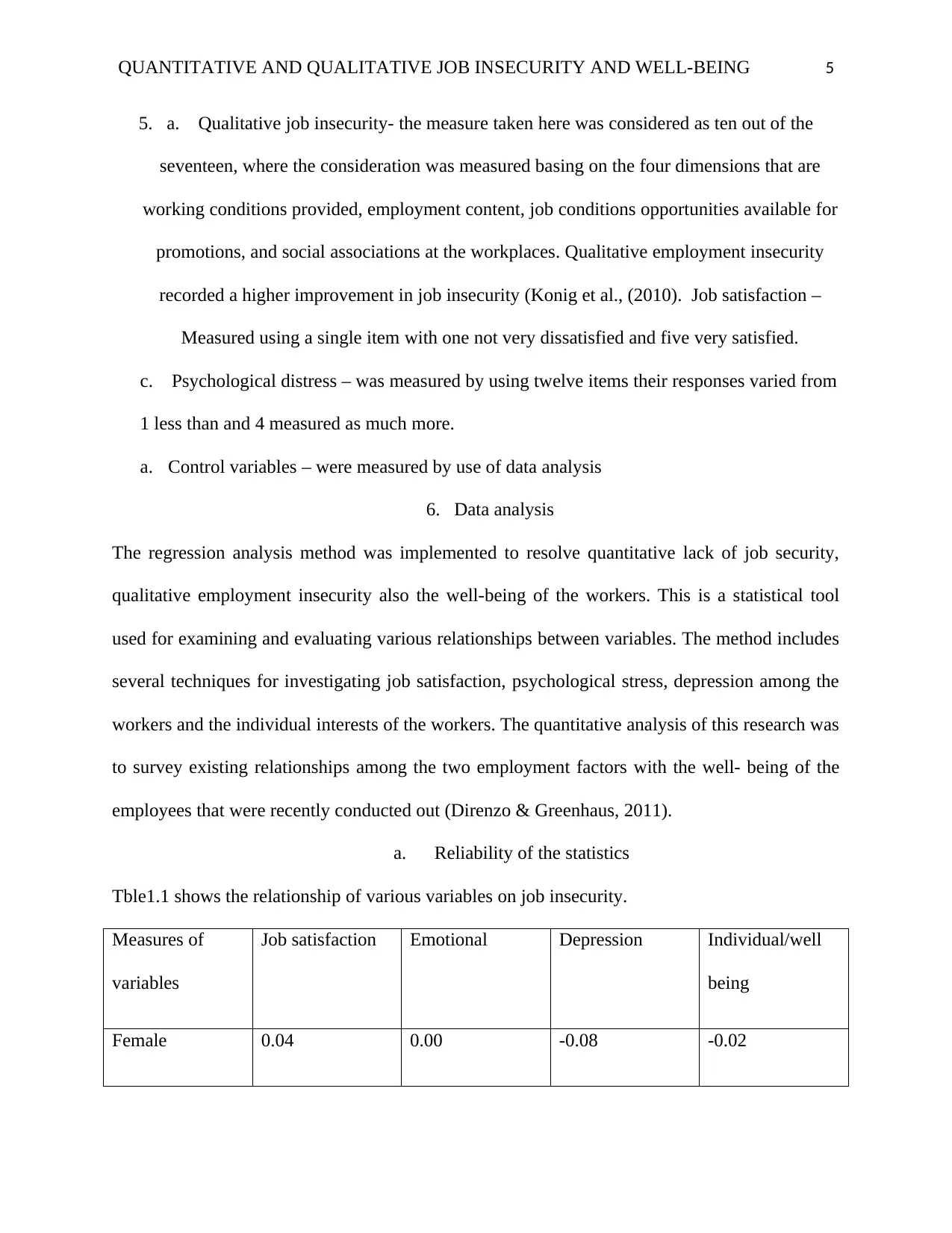
QUANTITATIVE AND QUALITATIVE JOB INSECURITY AND WELL-BEING 5
5. a. Qualitative job insecurity- the measure taken here was considered as ten out of the
seventeen, where the consideration was measured basing on the four dimensions that are
working conditions provided, employment content, job conditions opportunities available for
promotions, and social associations at the workplaces. Qualitative employment insecurity
recorded a higher improvement in job insecurity (Konig et al., (2010). Job satisfaction –
Measured using a single item with one not very dissatisfied and five very satisfied.
c. Psychological distress – was measured by using twelve items their responses varied from
1 less than and 4 measured as much more.
a. Control variables – were measured by use of data analysis
6. Data analysis
The regression analysis method was implemented to resolve quantitative lack of job security,
qualitative employment insecurity also the well-being of the workers. This is a statistical tool
used for examining and evaluating various relationships between variables. The method includes
several techniques for investigating job satisfaction, psychological stress, depression among the
workers and the individual interests of the workers. The quantitative analysis of this research was
to survey existing relationships among the two employment factors with the well- being of the
employees that were recently conducted out (Direnzo & Greenhaus, 2011).
a. Reliability of the statistics
Tble1.1 shows the relationship of various variables on job insecurity.
Measures of
variables
Job satisfaction Emotional Depression Individual/well
being
Female 0.04 0.00 -0.08 -0.02
5. a. Qualitative job insecurity- the measure taken here was considered as ten out of the
seventeen, where the consideration was measured basing on the four dimensions that are
working conditions provided, employment content, job conditions opportunities available for
promotions, and social associations at the workplaces. Qualitative employment insecurity
recorded a higher improvement in job insecurity (Konig et al., (2010). Job satisfaction –
Measured using a single item with one not very dissatisfied and five very satisfied.
c. Psychological distress – was measured by using twelve items their responses varied from
1 less than and 4 measured as much more.
a. Control variables – were measured by use of data analysis
6. Data analysis
The regression analysis method was implemented to resolve quantitative lack of job security,
qualitative employment insecurity also the well-being of the workers. This is a statistical tool
used for examining and evaluating various relationships between variables. The method includes
several techniques for investigating job satisfaction, psychological stress, depression among the
workers and the individual interests of the workers. The quantitative analysis of this research was
to survey existing relationships among the two employment factors with the well- being of the
employees that were recently conducted out (Direnzo & Greenhaus, 2011).
a. Reliability of the statistics
Tble1.1 shows the relationship of various variables on job insecurity.
Measures of
variables
Job satisfaction Emotional Depression Individual/well
being
Female 0.04 0.00 -0.08 -0.02
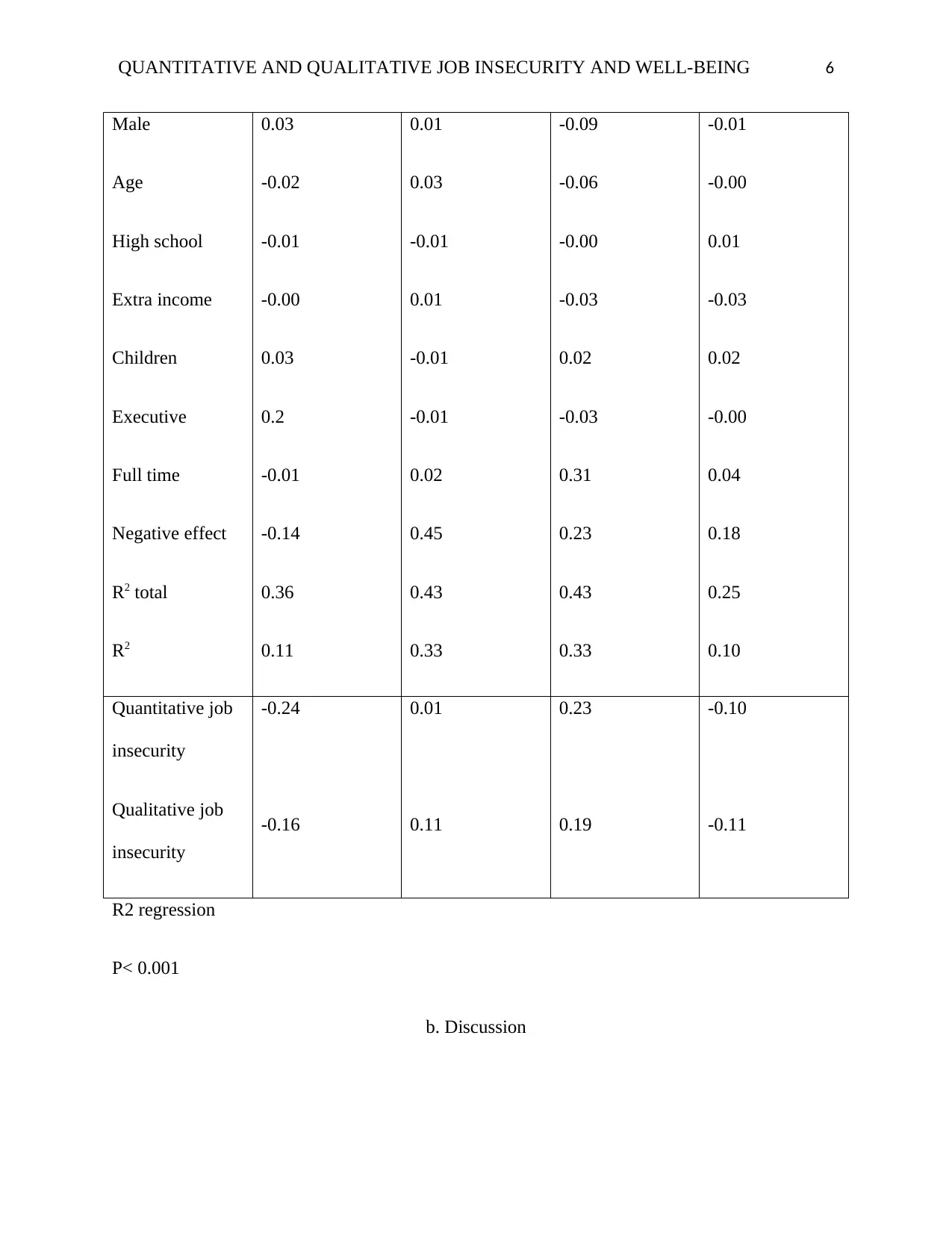
QUANTITATIVE AND QUALITATIVE JOB INSECURITY AND WELL-BEING 6
Male
Age
High school
Extra income
Children
Executive
Full time
Negative effect
R2 total
R2
0.03
-0.02
-0.01
-0.00
0.03
0.2
-0.01
-0.14
0.36
0.11
0.01
0.03
-0.01
0.01
-0.01
-0.01
0.02
0.45
0.43
0.33
-0.09
-0.06
-0.00
-0.03
0.02
-0.03
0.31
0.23
0.43
0.33
-0.01
-0.00
0.01
-0.03
0.02
-0.00
0.04
0.18
0.25
0.10
Quantitative job
insecurity
Qualitative job
insecurity
-0.24
-0.16
0.01
0.11
0.23
0.19
-0.10
-0.11
R2 regression
P< 0.001
b. Discussion
Male
Age
High school
Extra income
Children
Executive
Full time
Negative effect
R2 total
R2
0.03
-0.02
-0.01
-0.00
0.03
0.2
-0.01
-0.14
0.36
0.11
0.01
0.03
-0.01
0.01
-0.01
-0.01
0.02
0.45
0.43
0.33
-0.09
-0.06
-0.00
-0.03
0.02
-0.03
0.31
0.23
0.43
0.33
-0.01
-0.00
0.01
-0.03
0.02
-0.00
0.04
0.18
0.25
0.10
Quantitative job
insecurity
Qualitative job
insecurity
-0.24
-0.16
0.01
0.11
0.23
0.19
-0.10
-0.11
R2 regression
P< 0.001
b. Discussion
⊘ This is a preview!⊘
Do you want full access?
Subscribe today to unlock all pages.

Trusted by 1+ million students worldwide
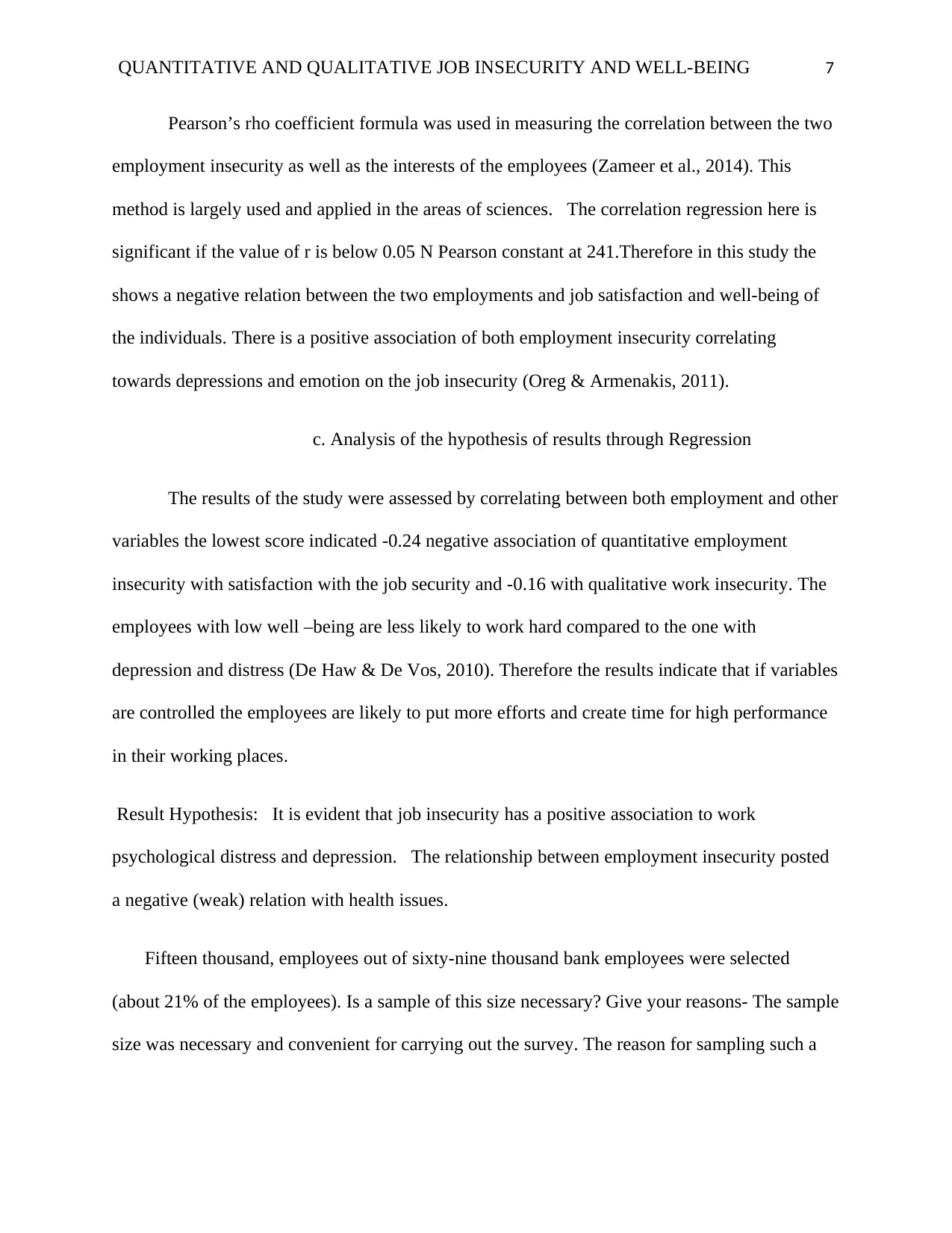
QUANTITATIVE AND QUALITATIVE JOB INSECURITY AND WELL-BEING 7
Pearson’s rho coefficient formula was used in measuring the correlation between the two
employment insecurity as well as the interests of the employees (Zameer et al., 2014). This
method is largely used and applied in the areas of sciences. The correlation regression here is
significant if the value of r is below 0.05 N Pearson constant at 241.Therefore in this study the
shows a negative relation between the two employments and job satisfaction and well-being of
the individuals. There is a positive association of both employment insecurity correlating
towards depressions and emotion on the job insecurity (Oreg & Armenakis, 2011).
c. Analysis of the hypothesis of results through Regression
The results of the study were assessed by correlating between both employment and other
variables the lowest score indicated -0.24 negative association of quantitative employment
insecurity with satisfaction with the job security and -0.16 with qualitative work insecurity. The
employees with low well –being are less likely to work hard compared to the one with
depression and distress (De Haw & De Vos, 2010). Therefore the results indicate that if variables
are controlled the employees are likely to put more efforts and create time for high performance
in their working places.
Result Hypothesis: It is evident that job insecurity has a positive association to work
psychological distress and depression. The relationship between employment insecurity posted
a negative (weak) relation with health issues.
Fifteen thousand, employees out of sixty-nine thousand bank employees were selected
(about 21% of the employees). Is a sample of this size necessary? Give your reasons- The sample
size was necessary and convenient for carrying out the survey. The reason for sampling such a
Pearson’s rho coefficient formula was used in measuring the correlation between the two
employment insecurity as well as the interests of the employees (Zameer et al., 2014). This
method is largely used and applied in the areas of sciences. The correlation regression here is
significant if the value of r is below 0.05 N Pearson constant at 241.Therefore in this study the
shows a negative relation between the two employments and job satisfaction and well-being of
the individuals. There is a positive association of both employment insecurity correlating
towards depressions and emotion on the job insecurity (Oreg & Armenakis, 2011).
c. Analysis of the hypothesis of results through Regression
The results of the study were assessed by correlating between both employment and other
variables the lowest score indicated -0.24 negative association of quantitative employment
insecurity with satisfaction with the job security and -0.16 with qualitative work insecurity. The
employees with low well –being are less likely to work hard compared to the one with
depression and distress (De Haw & De Vos, 2010). Therefore the results indicate that if variables
are controlled the employees are likely to put more efforts and create time for high performance
in their working places.
Result Hypothesis: It is evident that job insecurity has a positive association to work
psychological distress and depression. The relationship between employment insecurity posted
a negative (weak) relation with health issues.
Fifteen thousand, employees out of sixty-nine thousand bank employees were selected
(about 21% of the employees). Is a sample of this size necessary? Give your reasons- The sample
size was necessary and convenient for carrying out the survey. The reason for sampling such a
Paraphrase This Document
Need a fresh take? Get an instant paraphrase of this document with our AI Paraphraser
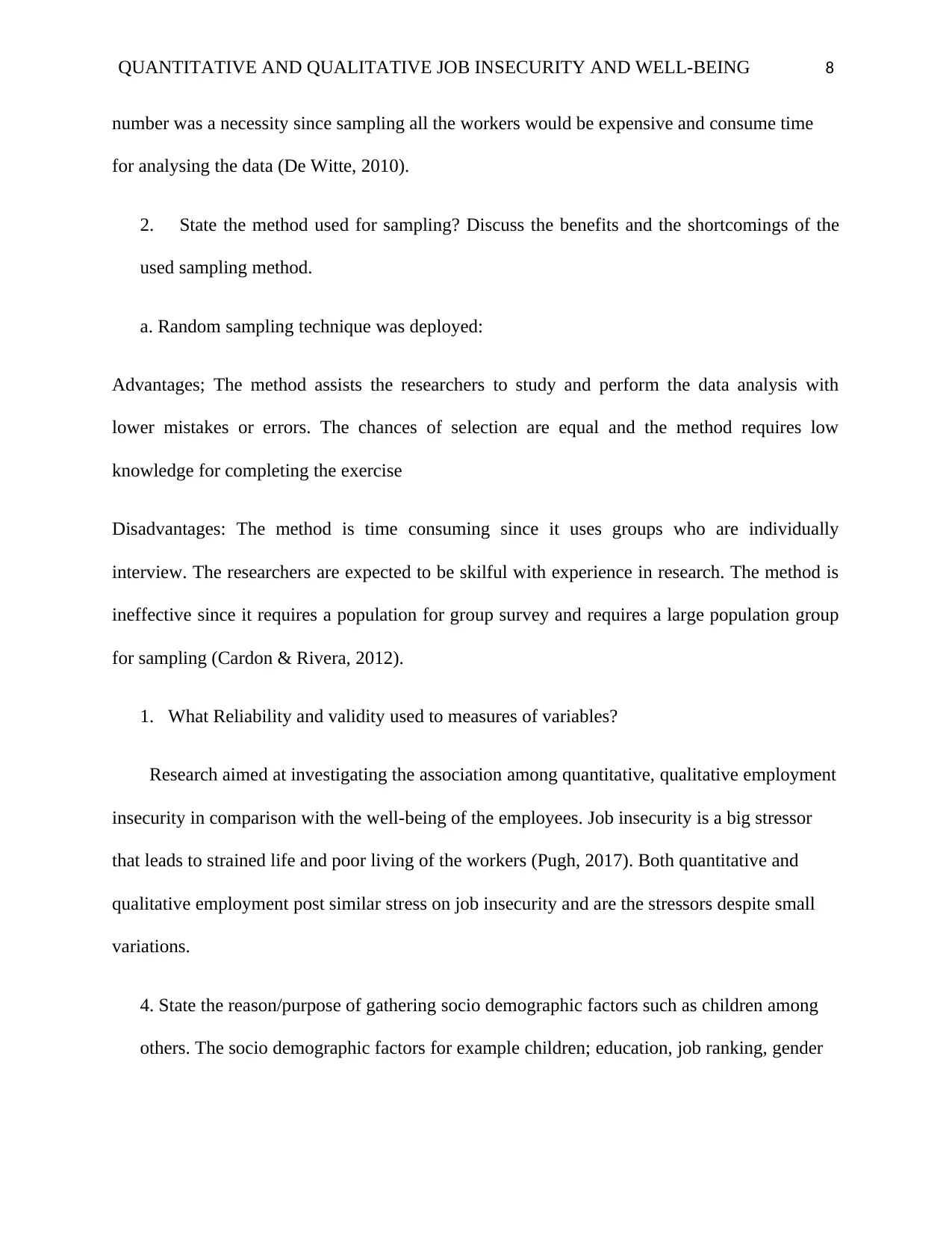
QUANTITATIVE AND QUALITATIVE JOB INSECURITY AND WELL-BEING 8
number was a necessity since sampling all the workers would be expensive and consume time
for analysing the data (De Witte, 2010).
2. State the method used for sampling? Discuss the benefits and the shortcomings of the
used sampling method.
a. Random sampling technique was deployed:
Advantages; The method assists the researchers to study and perform the data analysis with
lower mistakes or errors. The chances of selection are equal and the method requires low
knowledge for completing the exercise
Disadvantages: The method is time consuming since it uses groups who are individually
interview. The researchers are expected to be skilful with experience in research. The method is
ineffective since it requires a population for group survey and requires a large population group
for sampling (Cardon & Rivera, 2012).
1. What Reliability and validity used to measures of variables?
Research aimed at investigating the association among quantitative, qualitative employment
insecurity in comparison with the well-being of the employees. Job insecurity is a big stressor
that leads to strained life and poor living of the workers (Pugh, 2017). Both quantitative and
qualitative employment post similar stress on job insecurity and are the stressors despite small
variations.
4. State the reason/purpose of gathering socio demographic factors such as children among
others. The socio demographic factors for example children; education, job ranking, gender
number was a necessity since sampling all the workers would be expensive and consume time
for analysing the data (De Witte, 2010).
2. State the method used for sampling? Discuss the benefits and the shortcomings of the
used sampling method.
a. Random sampling technique was deployed:
Advantages; The method assists the researchers to study and perform the data analysis with
lower mistakes or errors. The chances of selection are equal and the method requires low
knowledge for completing the exercise
Disadvantages: The method is time consuming since it uses groups who are individually
interview. The researchers are expected to be skilful with experience in research. The method is
ineffective since it requires a population for group survey and requires a large population group
for sampling (Cardon & Rivera, 2012).
1. What Reliability and validity used to measures of variables?
Research aimed at investigating the association among quantitative, qualitative employment
insecurity in comparison with the well-being of the employees. Job insecurity is a big stressor
that leads to strained life and poor living of the workers (Pugh, 2017). Both quantitative and
qualitative employment post similar stress on job insecurity and are the stressors despite small
variations.
4. State the reason/purpose of gathering socio demographic factors such as children among
others. The socio demographic factors for example children; education, job ranking, gender
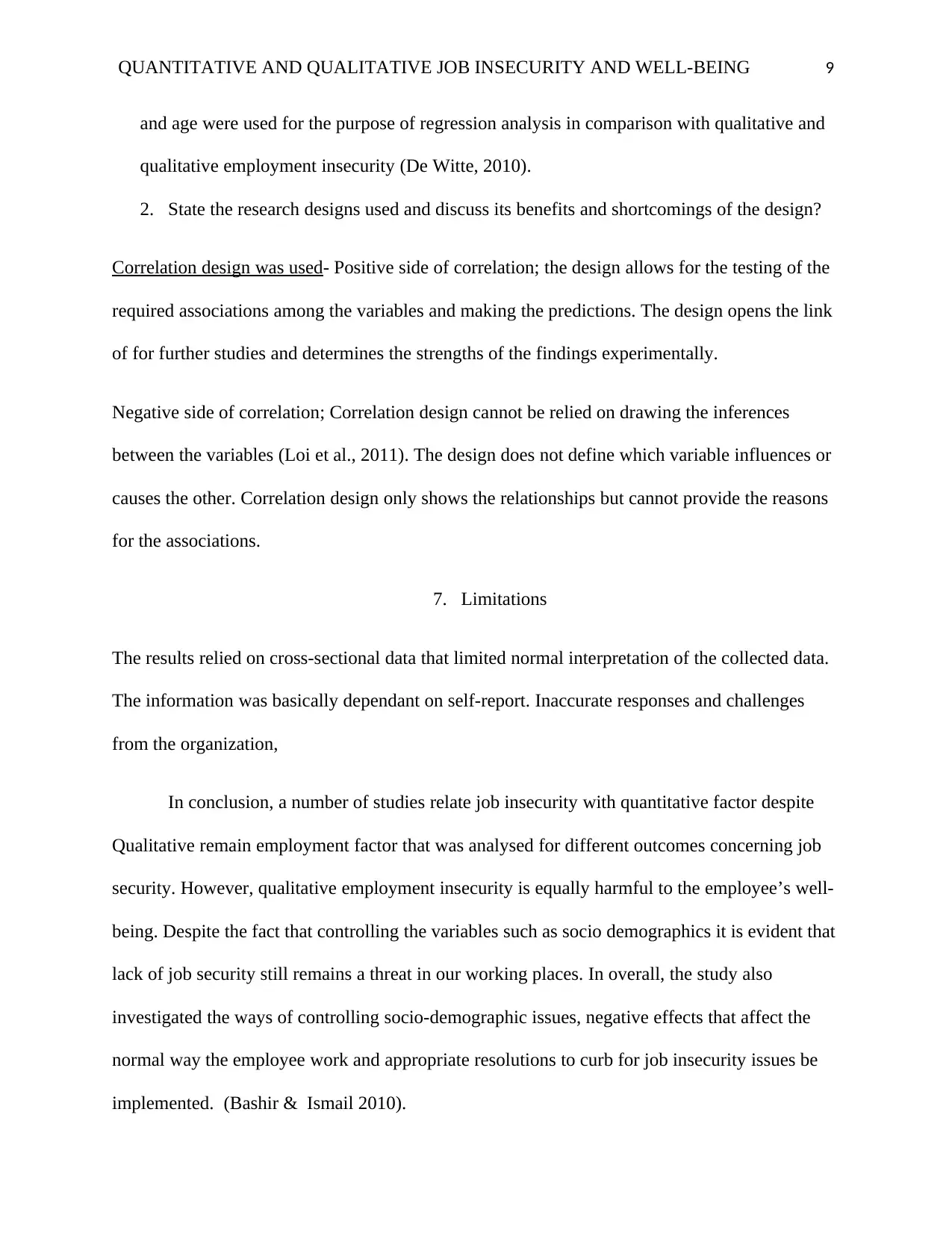
QUANTITATIVE AND QUALITATIVE JOB INSECURITY AND WELL-BEING 9
and age were used for the purpose of regression analysis in comparison with qualitative and
qualitative employment insecurity (De Witte, 2010).
2. State the research designs used and discuss its benefits and shortcomings of the design?
Correlation design was used- Positive side of correlation; the design allows for the testing of the
required associations among the variables and making the predictions. The design opens the link
of for further studies and determines the strengths of the findings experimentally.
Negative side of correlation; Correlation design cannot be relied on drawing the inferences
between the variables (Loi et al., 2011). The design does not define which variable influences or
causes the other. Correlation design only shows the relationships but cannot provide the reasons
for the associations.
7. Limitations
The results relied on cross-sectional data that limited normal interpretation of the collected data.
The information was basically dependant on self-report. Inaccurate responses and challenges
from the organization,
In conclusion, a number of studies relate job insecurity with quantitative factor despite
Qualitative remain employment factor that was analysed for different outcomes concerning job
security. However, qualitative employment insecurity is equally harmful to the employee’s well-
being. Despite the fact that controlling the variables such as socio demographics it is evident that
lack of job security still remains a threat in our working places. In overall, the study also
investigated the ways of controlling socio-demographic issues, negative effects that affect the
normal way the employee work and appropriate resolutions to curb for job insecurity issues be
implemented. (Bashir & Ismail 2010).
and age were used for the purpose of regression analysis in comparison with qualitative and
qualitative employment insecurity (De Witte, 2010).
2. State the research designs used and discuss its benefits and shortcomings of the design?
Correlation design was used- Positive side of correlation; the design allows for the testing of the
required associations among the variables and making the predictions. The design opens the link
of for further studies and determines the strengths of the findings experimentally.
Negative side of correlation; Correlation design cannot be relied on drawing the inferences
between the variables (Loi et al., 2011). The design does not define which variable influences or
causes the other. Correlation design only shows the relationships but cannot provide the reasons
for the associations.
7. Limitations
The results relied on cross-sectional data that limited normal interpretation of the collected data.
The information was basically dependant on self-report. Inaccurate responses and challenges
from the organization,
In conclusion, a number of studies relate job insecurity with quantitative factor despite
Qualitative remain employment factor that was analysed for different outcomes concerning job
security. However, qualitative employment insecurity is equally harmful to the employee’s well-
being. Despite the fact that controlling the variables such as socio demographics it is evident that
lack of job security still remains a threat in our working places. In overall, the study also
investigated the ways of controlling socio-demographic issues, negative effects that affect the
normal way the employee work and appropriate resolutions to curb for job insecurity issues be
implemented. (Bashir & Ismail 2010).
⊘ This is a preview!⊘
Do you want full access?
Subscribe today to unlock all pages.

Trusted by 1+ million students worldwide
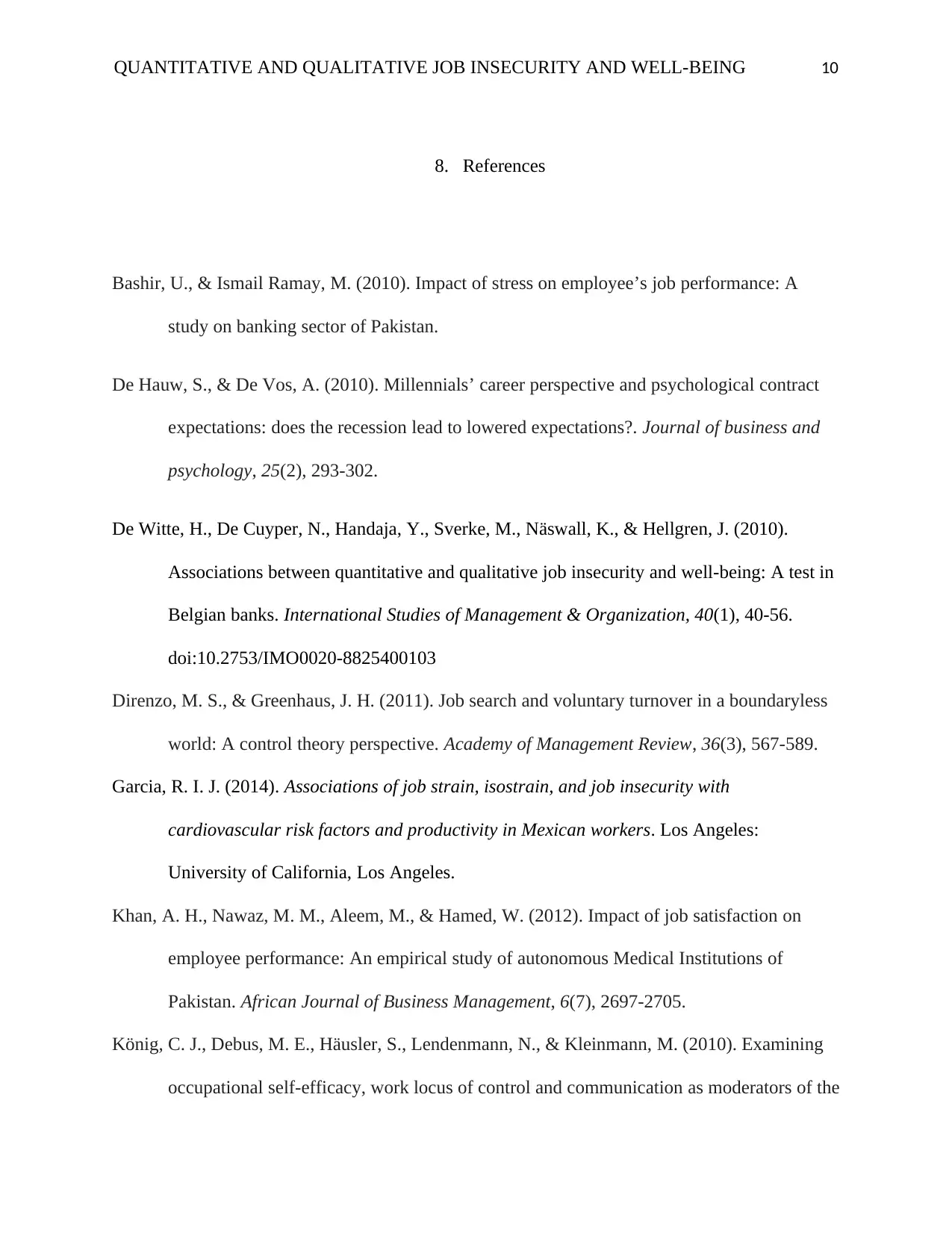
QUANTITATIVE AND QUALITATIVE JOB INSECURITY AND WELL-BEING 10
8. References
Bashir, U., & Ismail Ramay, M. (2010). Impact of stress on employee’s job performance: A
study on banking sector of Pakistan.
De Hauw, S., & De Vos, A. (2010). Millennials’ career perspective and psychological contract
expectations: does the recession lead to lowered expectations?. Journal of business and
psychology, 25(2), 293-302.
De Witte, H., De Cuyper, N., Handaja, Y., Sverke, M., Näswall, K., & Hellgren, J. (2010).
Associations between quantitative and qualitative job insecurity and well-being: A test in
Belgian banks. International Studies of Management & Organization, 40(1), 40-56.
doi:10.2753/IMO0020-8825400103
Direnzo, M. S., & Greenhaus, J. H. (2011). Job search and voluntary turnover in a boundaryless
world: A control theory perspective. Academy of Management Review, 36(3), 567-589.
Garcia, R. I. J. (2014). Associations of job strain, isostrain, and job insecurity with
cardiovascular risk factors and productivity in Mexican workers. Los Angeles:
University of California, Los Angeles.
Khan, A. H., Nawaz, M. M., Aleem, M., & Hamed, W. (2012). Impact of job satisfaction on
employee performance: An empirical study of autonomous Medical Institutions of
Pakistan. African Journal of Business Management, 6(7), 2697-2705.
König, C. J., Debus, M. E., Häusler, S., Lendenmann, N., & Kleinmann, M. (2010). Examining
occupational self-efficacy, work locus of control and communication as moderators of the
8. References
Bashir, U., & Ismail Ramay, M. (2010). Impact of stress on employee’s job performance: A
study on banking sector of Pakistan.
De Hauw, S., & De Vos, A. (2010). Millennials’ career perspective and psychological contract
expectations: does the recession lead to lowered expectations?. Journal of business and
psychology, 25(2), 293-302.
De Witte, H., De Cuyper, N., Handaja, Y., Sverke, M., Näswall, K., & Hellgren, J. (2010).
Associations between quantitative and qualitative job insecurity and well-being: A test in
Belgian banks. International Studies of Management & Organization, 40(1), 40-56.
doi:10.2753/IMO0020-8825400103
Direnzo, M. S., & Greenhaus, J. H. (2011). Job search and voluntary turnover in a boundaryless
world: A control theory perspective. Academy of Management Review, 36(3), 567-589.
Garcia, R. I. J. (2014). Associations of job strain, isostrain, and job insecurity with
cardiovascular risk factors and productivity in Mexican workers. Los Angeles:
University of California, Los Angeles.
Khan, A. H., Nawaz, M. M., Aleem, M., & Hamed, W. (2012). Impact of job satisfaction on
employee performance: An empirical study of autonomous Medical Institutions of
Pakistan. African Journal of Business Management, 6(7), 2697-2705.
König, C. J., Debus, M. E., Häusler, S., Lendenmann, N., & Kleinmann, M. (2010). Examining
occupational self-efficacy, work locus of control and communication as moderators of the
Paraphrase This Document
Need a fresh take? Get an instant paraphrase of this document with our AI Paraphraser
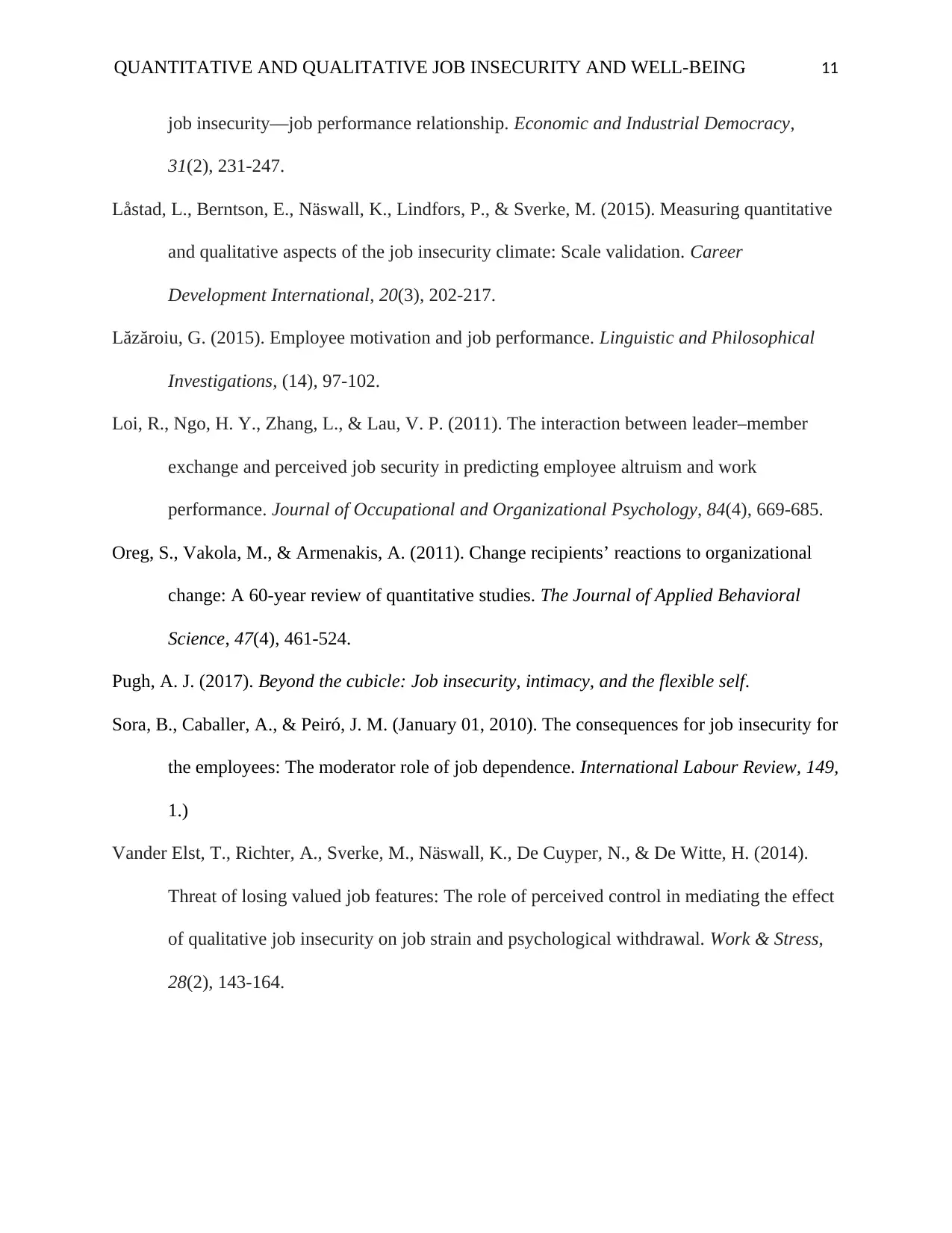
QUANTITATIVE AND QUALITATIVE JOB INSECURITY AND WELL-BEING 11
job insecurity—job performance relationship. Economic and Industrial Democracy,
31(2), 231-247.
Låstad, L., Berntson, E., Näswall, K., Lindfors, P., & Sverke, M. (2015). Measuring quantitative
and qualitative aspects of the job insecurity climate: Scale validation. Career
Development International, 20(3), 202-217.
Lăzăroiu, G. (2015). Employee motivation and job performance. Linguistic and Philosophical
Investigations, (14), 97-102.
Loi, R., Ngo, H. Y., Zhang, L., & Lau, V. P. (2011). The interaction between leader–member
exchange and perceived job security in predicting employee altruism and work
performance. Journal of Occupational and Organizational Psychology, 84(4), 669-685.
Oreg, S., Vakola, M., & Armenakis, A. (2011). Change recipients’ reactions to organizational
change: A 60-year review of quantitative studies. The Journal of Applied Behavioral
Science, 47(4), 461-524.
Pugh, A. J. (2017). Beyond the cubicle: Job insecurity, intimacy, and the flexible self.
Sora, B., Caballer, A., & Peiró, J. M. (January 01, 2010). The consequences for job insecurity for
the employees: The moderator role of job dependence. International Labour Review, 149,
1.)
Vander Elst, T., Richter, A., Sverke, M., Näswall, K., De Cuyper, N., & De Witte, H. (2014).
Threat of losing valued job features: The role of perceived control in mediating the effect
of qualitative job insecurity on job strain and psychological withdrawal. Work & Stress,
28(2), 143-164.
job insecurity—job performance relationship. Economic and Industrial Democracy,
31(2), 231-247.
Låstad, L., Berntson, E., Näswall, K., Lindfors, P., & Sverke, M. (2015). Measuring quantitative
and qualitative aspects of the job insecurity climate: Scale validation. Career
Development International, 20(3), 202-217.
Lăzăroiu, G. (2015). Employee motivation and job performance. Linguistic and Philosophical
Investigations, (14), 97-102.
Loi, R., Ngo, H. Y., Zhang, L., & Lau, V. P. (2011). The interaction between leader–member
exchange and perceived job security in predicting employee altruism and work
performance. Journal of Occupational and Organizational Psychology, 84(4), 669-685.
Oreg, S., Vakola, M., & Armenakis, A. (2011). Change recipients’ reactions to organizational
change: A 60-year review of quantitative studies. The Journal of Applied Behavioral
Science, 47(4), 461-524.
Pugh, A. J. (2017). Beyond the cubicle: Job insecurity, intimacy, and the flexible self.
Sora, B., Caballer, A., & Peiró, J. M. (January 01, 2010). The consequences for job insecurity for
the employees: The moderator role of job dependence. International Labour Review, 149,
1.)
Vander Elst, T., Richter, A., Sverke, M., Näswall, K., De Cuyper, N., & De Witte, H. (2014).
Threat of losing valued job features: The role of perceived control in mediating the effect
of qualitative job insecurity on job strain and psychological withdrawal. Work & Stress,
28(2), 143-164.
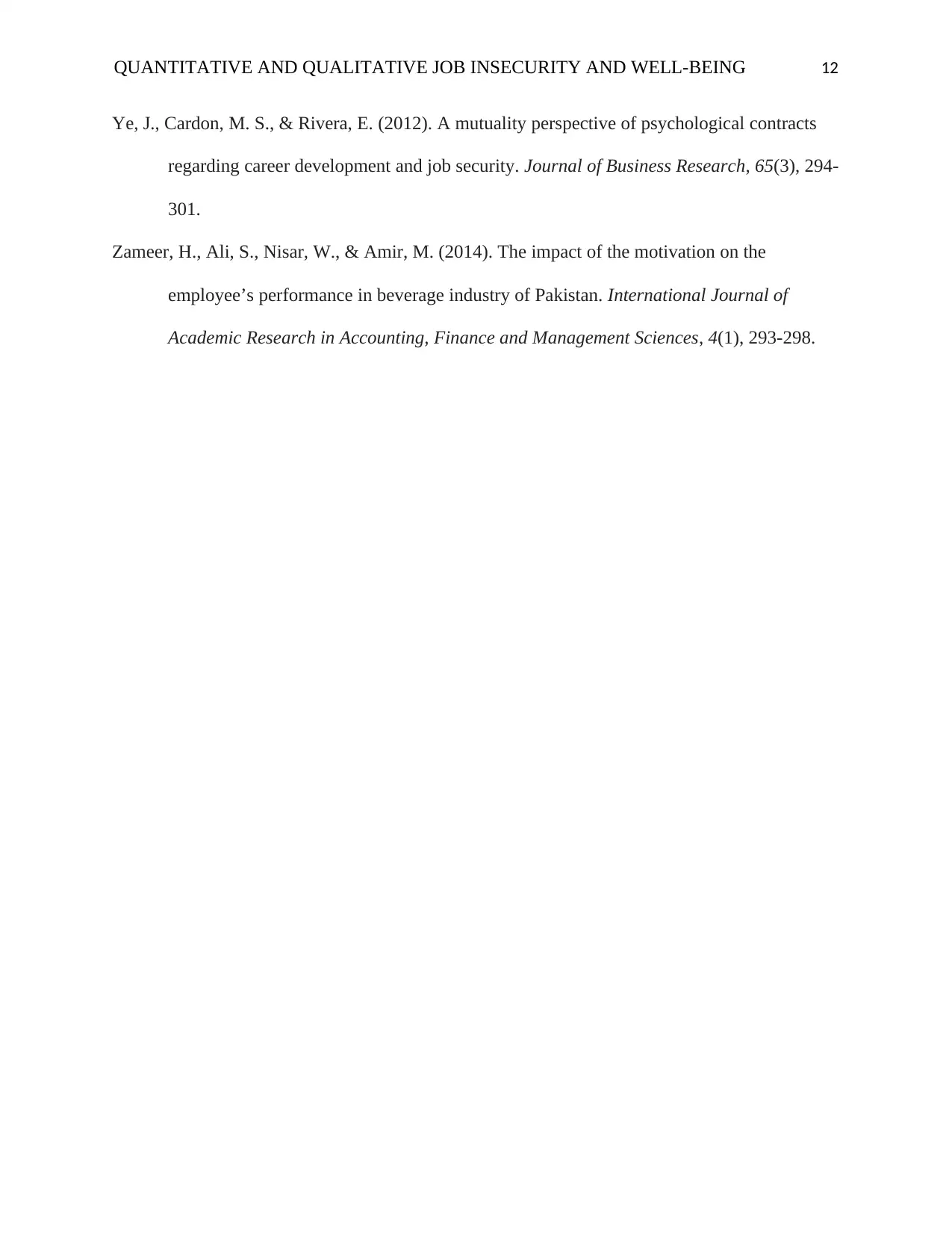
QUANTITATIVE AND QUALITATIVE JOB INSECURITY AND WELL-BEING 12
Ye, J., Cardon, M. S., & Rivera, E. (2012). A mutuality perspective of psychological contracts
regarding career development and job security. Journal of Business Research, 65(3), 294-
301.
Zameer, H., Ali, S., Nisar, W., & Amir, M. (2014). The impact of the motivation on the
employee’s performance in beverage industry of Pakistan. International Journal of
Academic Research in Accounting, Finance and Management Sciences, 4(1), 293-298.
Ye, J., Cardon, M. S., & Rivera, E. (2012). A mutuality perspective of psychological contracts
regarding career development and job security. Journal of Business Research, 65(3), 294-
301.
Zameer, H., Ali, S., Nisar, W., & Amir, M. (2014). The impact of the motivation on the
employee’s performance in beverage industry of Pakistan. International Journal of
Academic Research in Accounting, Finance and Management Sciences, 4(1), 293-298.
⊘ This is a preview!⊘
Do you want full access?
Subscribe today to unlock all pages.

Trusted by 1+ million students worldwide
1 out of 12
Related Documents
Your All-in-One AI-Powered Toolkit for Academic Success.
+13062052269
info@desklib.com
Available 24*7 on WhatsApp / Email
![[object Object]](/_next/static/media/star-bottom.7253800d.svg)
Unlock your academic potential
Copyright © 2020–2025 A2Z Services. All Rights Reserved. Developed and managed by ZUCOL.





